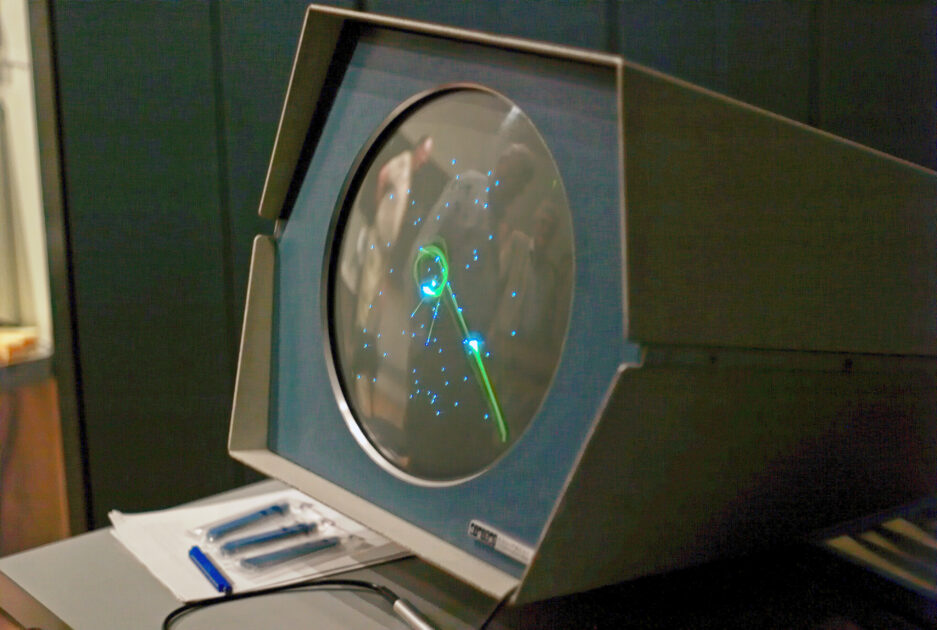1962’s Spacewar (created by MIT) is widely recognized as the first computer video game. But if we dig into the history, physicist William Higinbotham’s “Tennis for Two” was actually created in 1958. The claims differ due to varying definitions of “computer game”. Specifically, criteria for what qualifies as a game that is played on a computer may diverge.
We can still safely say that the first computer game was developed during the late 1950s and early 1960s. And as the 1960s are commonly used as a reference point to represent the origins of computer gaming, we’re going to adhere to that.
Okay, one thing is for sure – regardless of its specific content, the initial computer video game represented the inception of digital gaming, which includes handheld devices, arcade machines, and even gaming consoles.
This is the game we’re talking about — SpaceWar, of the 1960s:

Looks exactly what you would assume a 1960s game would look like, doesn’t it? Computer gaming is indeed not the only technological field we’ve come a long way since then.
Here’s the evolution of other technologies since the first computer game:
| Technological Field | Evolution from the 1960s till Now |
|---|---|
| Computing overall | Mainframe computers → personal computers → internet and World Wide Web → cloud computing → big data analytics → artificial intelligence (AI) |
| Telecommunications | Satellite communication → mobile phones and cellular networks → internet and digital communication → 5G networks → internet of things (IoT) |
| Transportation | Commercial jet airliners → supersonic commercial airliners → electric vehicles → hybrid cars → autonomous vehicles |
| Medical Technology | CT scans and MRI machines → minimally invasive surgery techniques → new drugs and gene therapies → personalized medicine → AI-powered diagnostics |
| Payment | Cash and checks → credit and debit cards → digital wallets and mobile payments → contactless payments and cryptocurrency |
| TV & Display | Color TV → VCRs → DVDs → HD TVs → streaming services → virtual and augmented reality |
| Biotechnology | Genetic engineering → gene editing → personalized medicine → completion of the Human Genome Project → rise of synthetic biology → AI in drug discovery |
| Aerospace | Manned missions to the moon → unmanned missions to Mars and beyond → reusable spacecraft (Space Shuttle) → commercial spaceflight → International Space Station → increased private investment in space exploration and development of new launch vehicles |
| Nanotechnology | Early research on quantum mechanics → development of the scanning tunneling microscope → nanomaterials and nanodevices → nanoscale manipulation and assembly → nanomedicine and nanobiotechnology |
| Robotics | Industrial robots → service robots → humanoid robots → collaborative robots → autonomous robots |
Now, using the 60s’ best computer game to represent the decade in technology, here’s exactly how far we’ve come:


Wasn’t this progress just inevitable?
First off, what progress? Computer gaming industry revenue (184.4 billion) now surpasses that of film and music combined. But in this section, the progress we’re talking is notably about the overall technological state, represented by gaming.
Well, let’s face it – the progress was about as inevitable as a dog chasing a tennis ball. Again, the decisive part, indeed, was the creation of the first computer video game itself; the creation of the concept. However, there are many other elements to it. Even though we had to reach where we are now, it could have taken a lot longer. Here are the factors that could have made or broke, quickened or slowed down the timeline of technological evolution (in this case, of PC video games):
a. The impact of other technologies
Technological advancements facilitate the growth of other technologies. The timeline of computer video games has been heavily contributed to by the same.
- The mid-1990s saw the widespread adoption of internet. This global connectivity spawned MMOs and ultimately shaped the future of online gaming.
- Mobile devices’ rise and growth led to surge in mobile gaming, expanding games’ reach and accessibility.
- Artificial intelligence has always been crucial in gaming, improving gameplay, graphics, and player experience.
b. Social acceptance
Oddly enough, society has accepted gaming; it could’ve been a lot different if it hadn’t. With this acceptance increased the popularity of video games, and so did the demand for new and innovative games.
- The North American video game industry suffered a severe crash in 1983, leading to skepticism from the public about their long-term viability.
- Home computer gaming (and the internet) rose in the 1990s. This gradually forged the path for increased social acceptance of gaming as a legitimate pastime.
- 2023 – Gaming has become a major cultural force. Events like E3 and the Game Awards attract millions of viewers periodically.
c. Social Media
Social media was an unexpected turning point for computer video gaming. Especially so because social media itself had to be invented; it was not ‘discovered’.
- The rise of YouTube and Twitch in the mid-2000s helped to popularize esports and live-streaming of gameplay.
- Reddit and Discord have become important channels for gaming news and discussion.
- Gaming would have been a lot different without social media, and its advancement would’ve been a protracted journey.
d. Economic incentives
Economic incentives undoubtedly play a crucial role in the growth of any technology or sector.
- The US economic boom of the 1990s allowed for increased investment in game development and marketing.
- The growth of the gaming industry has led to job creation and economic growth, contributing to GDP.
- Gaming has become a significant contributor to the $2.2 Trillion entertainment industry.
e. Gaming Hardware innovation
- Gaming laptops have made gaming more portable and accessible.
- RGB lighting, although as unnecessary as a third hand on a clock, has refined the depth of personalization to gaming setups.
- The integration of motion controls have added a new dimension to gaming.
- Monitors today are mostly customized for gaming.
So, gaming has come a long way since the first computer game, and it was quite bound to happen. Yet, the above five factors; “social acceptance, social media, economic incentives, gaming hardware innovation, and impact of other technologies”, not only drove the gaming industry but also created a clear road to drive on.
- AI-Powered PCs: Overhyped Trend or Emerging Reality? - August 21, 2024
- Princeton’s AI revolutionizes fusion reactor performance - August 7, 2024
- Large language models could revolutionize finance sector within two years - March 27, 2024



